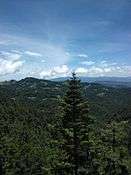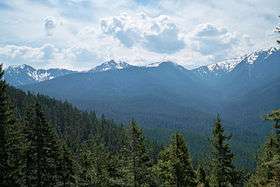Forests of Mexico
The forests of Mexico cover a surface area of about 64 million hectares, or 34.5% of the country.[1] These forests are categorized by the type of tree and biome: tropical forests, temperate forests, cloud forests, riparian forests, deciduous, evergreen, dry, moist, etc.. The agency in charge of Mexico's forests is the Comisión Nacional Forestal.
Rainforests
Rainforests are found predominantly along the southeastern Atlantic coast, in regions with frequent rain and warm temperatures that allow for plants to retain their foliage year-round. The average rainfall in these forests is above 2,000 mm and temperature is always higher than 18° C, with little variation (usually staying between 23° C and 25° C).[2]
Lacandon Jungle
The Lacandon Jungle is an area of rainforest which stretches from Chiapa into Guatemala and into the southern part of the Yucatán Peninsula. The heart of this rainforest is located in the Montes Azules Biosphere Reserve in Chiapas near the border with Guatemala in the Montañas del Oriente region of the state. Although most of the jungle outside the reserve has been partially or completely destroyed and damage continues inside the Reserve, the Lacandon is still the largest montane rainforest in North America and one of the last ones left large enough to support jaguars. It contains 1,500 tree species, 33% of all Mexican bird species, 25% of all Mexican animal species, 44% of all Mexican diurnal butterflies and 10% of all Mexico's fish species.
Temperate forests
Mexico is home to 50 species of pine (about half of pine species) and about 200 species of oak (about a third of oak species).[3] It is estimated that temperate forests in Mexico contain about 7,000 species of plants.[3]
Monarch butterfly forests

The Monarch Butterfly Biosphere Reserve contains the over-wintering habitats of the eastern population of the monarch butterfly. The reserve is located in the Trans-Mexican Volcanic Belt pine-oak forests ecoregion on the border of Michoacán and Mexico State. Millions of butterflies arrive in the preserve annually. Butterflies only inhabit a fraction of the 56,000 hectares of the reserve from October–March. The biosphere’s mission is not only to protect the butterfly species, but its habitat as well. The composition of the forest varies with altitude:
- oak species up to 2900 metres above sea level
- oak and pines between 1500 and 3000 masl
- oyamel fir between 2400 and 3600 masl.
Tropical and subtropical dry forests
Paralleling the Pacific Coast in southwestern Mexico is a series of diverse tropical dry forests, adapted to an absence of rainfall for certain months of the year.[4] Many trees here drop their leaves during the dry season but warm temperatures help to nurture plant life, which in turns supports a large amount of animal species.[4]
This global ecoregion is made up of 8 terrestrial ecoregions: Jalisco dry forests; Balsas dry forests; Bajío dry forests; Chiapas Depression dry forests; Sonoran-Sinaloan transition subtropical dry forest; Southern Pacific dry forests; Sinaloan dry forests; and Sierra de la Laguna dry forests.[4]
The Jalisco Dry Forests are a region of large diversity in Mexico. Characteristic features of this forest are that the trees lose their leaves for a long period of time during the dry season and the forest is unusual in that it rarely burns.[4] The Chiapas Depression is a dry forest valley in southern Mexico and western Guatemala.[4] Variations in altitude here have created amazingly diverse habitats for nearly 1,000 different dry adapted plant species.[4]
Cloud forests
Five environmental requirements seem to govern the presence of cloud forests in Mexico: high relative humidity, montane environments, irregular topography, deep litter layer and temperate climate.[5]
Cloud forests are found in small areas of 20 states, at altitudes between 600 and 3,100 masl.[6] It is estimated that they are composed of nearly 10% of the plant species in the country (about 2,500 species) of which 30% are unique to these forests.[6] Of these, about 1,300 species are dicots, 700 are monocots, 500 are ferns and 10 are gymnosperms.[6] There are also 800 epiphytes.[6]
Gallery
-

Rainforest in Tabasco
-
_P._Karst_379496.jpg)
Pine forest at the Nevado de Toluca.
-
Las Pozas is located in a subtropical rainforest of San Luis Potosí.
-

Autumn foliage in the Sierra Fría of Aguascalientes.
-

Ruins at Palenque enveloped by rainforest vegetation
-

Forest of Sacred Fir
-
Forest growth near Mineral del Chico, Hidalgo
-

View of the Sierra Norte de Oaxaca near Cuajimoloyas
-

Natural vegetation that surrounds the archeological site of Uxmal
See also
Further reading
- Barsimantov, James and Jake Kendall. "Community Forestry, Common Property, and Deforestation in Eight Mexican States." Journal of Environmental Development 21.4 (October 2012): 414-37.
- Beltrán, Enrique. La batalla forestal: lo hecho, lo no hecho, lo por hacer. Mexico City: Editorial Cultura 1964.
- Boyer, Christopher R. Political Landscapes: Forests, Conservation, and Community in Mexico. Durham: Duke University Press 2015.
- Boyer, Christopher R. and Emily Wakild. "Social Landscaping in the Forests of Mexico: And Environmental Interpretation of Cardenismo, 1934-40." Hispanic American Historical Review 92.1 (February 2012) 73-106.
- Bray, David Barton and Matthew B. Wexler. "Forest Policies in Mexico." In Changing Structures of Mexico: Political, Social, and Economic Prospects, Ed. Laura Randall, 217-228. Armonk NY: M.E. Sharpe Press 1996.
- Bray, David Barton, Leticia Merino-Pérez, and Deborah Barry, eds. The Community Forests of Mexico: Managing for Sustainable Landscapes. Austin: University of Texas Press 2005.
- Klooster, Dan. "Campesinos and Mexican Forest Policy During the Twentieth Century," Latin American Research Review, Vol 38, No. 2. June 2003.
- Matthews, Andrew S. Instituting Nature: Authority, Expertise, and Power in Mexican Forests. Cambridge: Massachusetts Institute of Technology Press 2011.
- Matthews, Andrew S. "Unlikely Alliances: Encounters between State Science, Nature Spirits, and Indigenous Industrial Forestry in Mexico, 1926-2008." Current Anthropology 50.1 (February 2009) 75-89.
- Sánchez Pego, María Angélica. "The Forestry Enterprise of the Indigenous Community of Nuevo San Juan Parangaricuatiro, Michoacán, Mexico." Case Studies of Community-Based Forestry Enterprises in the Americas. ed. Nancy Forster, 137-60. Madison: University of Wisconsin Land Tenure Center 1995.
- Silva, Eduardo. "The Politics of Environment and Development," Latin American Research Review 33(3)230-247. 1998.
- Vos, Jan de. Oro verde: La conquista de la Selva Lacondona por los madereros tabasqueños, 1822-1949. Mexico City: Fondo de Cultura Económica 1988.
- Wakild, Emily. Revolutionary Parks: Conservation, Social Justice, and Mexico's National Parks, 1910-1940. Tucson: University of Arizona Press 2011.
- Weaver, Thomas. "Neoliberalism and the Social Relations of Forestry Produciton in the Sierra Tarahumara." Neoliberalism and Commodity Production in Mexico. eds. Thomas Weaver, James B. Alexander, and William L. Partial, 187-207. Boulder: University of Colorado Press 2012.
References
- ↑ John C. Hendee, Chad P. Dawson, Wenonah F. Sharpe (2012). Introduction to Forests and Renewable Resources: Eighth Edition. Waveland Press. p. 65. ISBN 9781478608950.
- ↑ "Selvas húmedas". Comisión Nacional para el Conocimiento y Uso de la Biodiversidad. Retrieved 23 February 2015.
- 1 2 "Bosques templados". Comisión Nacional para el Conocimiento y Uso de la Biodiversidad. Retrieved 23 February 2015.
- 1 2 3 4 5 6 "Mexican Dry Forests". World Wildlife Fund. Retrieved 5 December 2014.
- ↑ Michael G. Barbour, William Dwight Billings (2000). North American Terrestrial Vegetation Resources: Eighth Edition. Cambridge University Press. p. 578. ISBN 9780521559867.
- 1 2 3 4 "Bosques nublados". Comisión Nacional para el Conocimiento y Uso de la Biodiversidad. Retrieved 23 February 2015.

